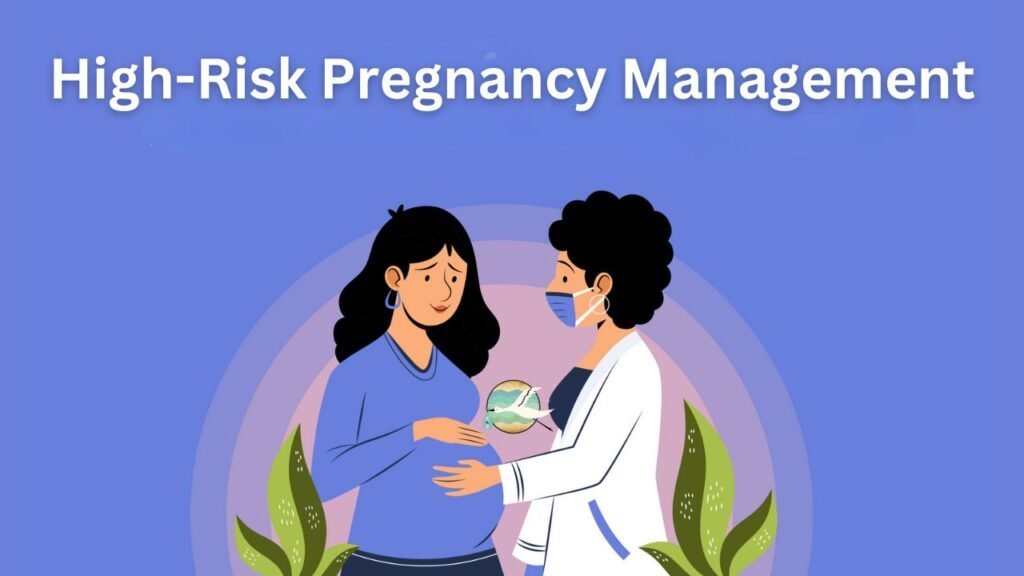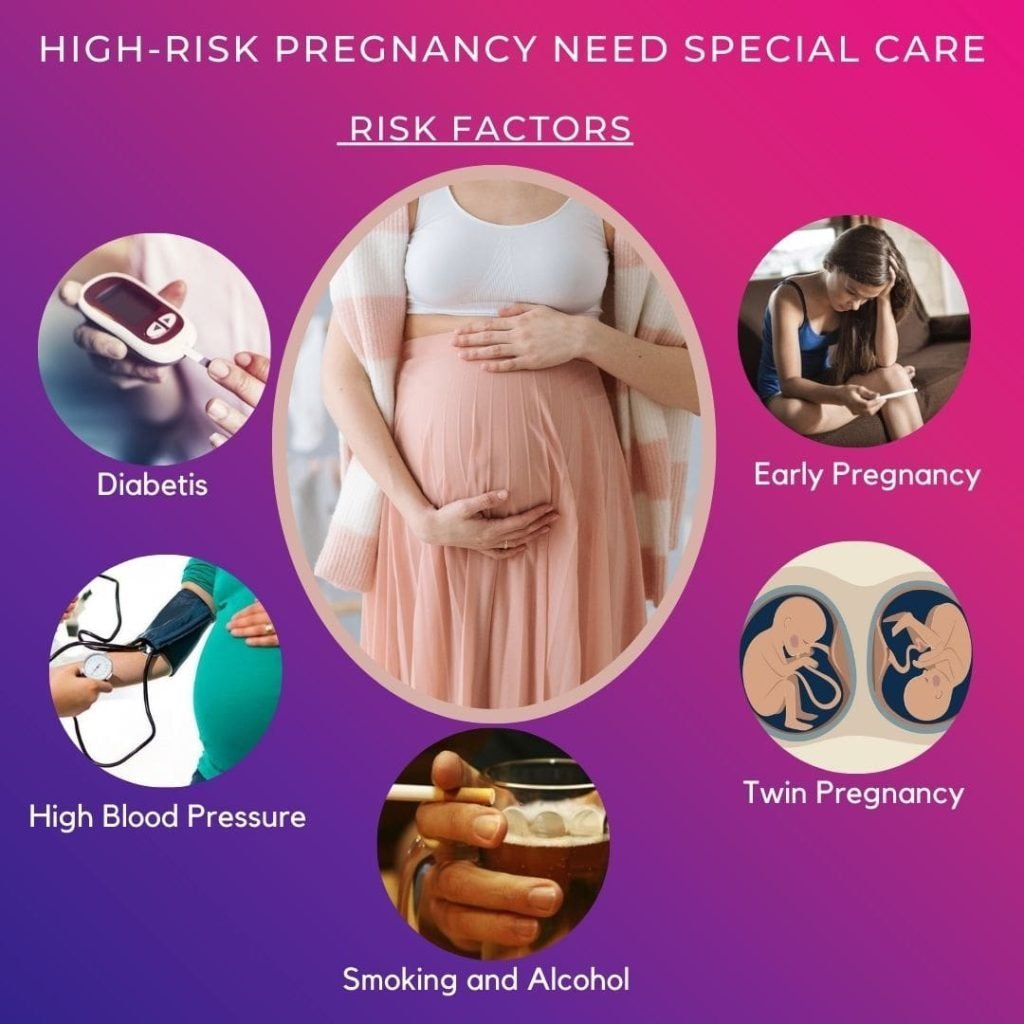Learn the Symptoms of High-Risk Pregnancy and learn about potential issues. To have a safe and healthy pregnancy, learn when to consult a doctor.
Table of Contents
A woman’s pregnancy is a spectacular and life-changing experience. While the majority of pregnancies go successfully, some may be deemed high-risk due to a variety of variables that could potentially have an impact on the mother’s and the baby’s health. Understanding the signs of a high-risk pregnancy is essential for early intervention and the right kind of medical attention. In this thorough guide, we will examine the signs and symptoms of high-risk pregnancies, illuminating potential issues and emphasizing the significance of receiving prompt medical care.

Symptoms of High-Risk Pregnancy
Pregnant women who experience any of the following symptoms should seek immediate medical attention since they may be in a high-risk situation:
Vaginal Bleeding
Vaginal bleeding is one of the worrying indicators of a high-risk pregnancy. Light spotting may be normal, but heavy or prolonged bleeding may be a sign of a miscarriage or placental abruption, both of which require rapid medical attention.
Severe Nausea and Vomiting
Even though morning sickness is typical throughout pregnancy, persistent gaseousness and vomiting can cause dehydration and malnutrition, risking both the mother and the unborn child.
High Blood Pressure
Preeclampsia is a dangerous illness that affects organ function and blood flow and can be detected by elevated blood pressure levels. To avoid difficulties, it needs careful management and monitoring.
Abdominal Pain
Intense abdominal pain might indicate problems like ectopic pregnancy or premature labor. Any persistent or severe pain should be evaluated promptly.
Stay tuned for the next section, where we’ll explore pre-existing conditions that contribute to high-risk pregnancies.
Pre-existing Conditions
Diabetes: Diabetes increases the chance of pregnancy issues, such as birth abnormalities and premature birth, for expectant mothers. It’s crucial to keep a close eye on things and manage your blood sugar.
Hypertension: Preeclampsia can result from gestational hypertension or high blood pressure before getting pregnant. Prenatal care and routine blood pressure monitoring are essential for controlling these problems.
Autoimmune Disorders: The risk of pregnancy difficulties can increase if a person has certain autoimmune diseases, such as lupus and rheumatoid arthritis. It’s frequently advised to use communication between an obstetrician and a specially
Advanced Maternal Age
Risks and Considerations: Over-35-year-old pregnant women are regarded as having an advanced maternal age pregnancy. Despite the fact that many pregnant women in this age group have healthy babies, there is a higher chance of genetic anomalies and medical issues.
Genetic Testing: Genetic testing is frequently used in advanced maternal-age pregnancies to look for any chromosomal problems. Making decisions about the pregnancy can be aided by early identification of the condition.
Gestational Complications

Gestational Diabetes: Pregnancy-related diabetes alters how your cells use sugar, raising your risk for larger babies, cesarean deliveries, and type 2 diabetes in the future. Diet, exercise, and occasionally medication management are essential for controlling blood sugar levels.
Preeclampsia: Preeclampsia, which is characterized by elevated blood pressure and organ damage, can be dangerous for both the mother and the unborn child. Prenatal care given regularly aids in managing and monitoring this illness.
Placental Problems: Placental problems, such as placenta previa or placental abruption, can cause bleeding and limit the baby’s oxygen supply. A prompt medical response is essential.
Lifestyle Factors
Smoking and Substance Abuse: The use of tobacco and other drugs increases the chance of difficulties, such as preterm birth, low birth weight, and developmental problems, greatly throughout pregnancy.
Poor Nutrition and Obesity
Obesity and improper diet can cause gestational diabetes, high blood pressure, and challenges in giving birth. Regular exercise and a healthy diet are crucial.
Recognizing Fetal Distress
Decreased Fetal Movement
The baby may be in distress if its movements slow down. If you see a marked drop in fetal activity, get in touch with your doctor.
Irregular Heartbeat
If an abnormal heartbeat is discovered during prenatal exams, more testing may be required. Your doctor will decide what has to be done to protect the baby’s health.
Meconium in Amniotic Fluid
Meconium, the infant’s first feces, could indicate fetal distress if it is found in the amniotic fluid. The newborn’s breathing after birth may be impacted.

High-Risk Pregnancy Management
These are undoubtedly the most important guidelines for handling a high-risk pregnancy:
- Prenatal Care: Regular and thorough prenatal check-ups are crucial.
- Healthcare Collaboration: Work with specialists like maternal-fetal medicine experts.
- Lifestyle Changes: Maintain a balanced diet, manage weight, and stay active.
- Medications: Adjust medications as needed under medical guidance.
- Antenatal Corticosteroids: Used for lung maturation in potential preterm birth.
- Monitoring: Close monitoring may be required, possibly leading to hospitalization.
- Emotional Support: Seek support from loved ones and professionals.
- Positive Outlook: Proactive management enhances the chances of a positive outcome.
Remember, personalized care and communication with healthcare providers are essential for managing a high-risk pregnancy successfully.
Related Post:
- When to do a pregnancy test after blastocyst transfer? Crucial Phase in Early Pregnancy
- What is a Good AMH Level to Get Pregnant?
- Are Painful Periods a Sign of Good Fertility?
FAQs About High-Risk Pregnancy
Q. What are the main causes of a high-risk pregnancy?
Pregnancy problems in the past can lead to high-risk pregnancies, as can maternal age (very young or older), prior medical issues (diabetes, hypertension), multiple pregnancies (twins or more), and multiple pregnancies.
Q. Can a high-risk pregnancy be managed?
Yes, Many high-risk pregnancies can be successfully managed with the right medical attention and supervision to guarantee the best outcome for both mother and child.
Q. In a high-risk pregnancy, how frequently should I visit my doctor?
Depending on the conditions of each patient, the frequency of doctor visits may change. However, more frequent prenatal checkups and specialist care are needed for the majority of high-risk pregnancies.
Q. Are all complications during pregnancy considered high-risk?
Complications do not always point to a high-risk pregnancy. Some issues are typical and manageable without seriously endangering the mother’s or the baby’s health.
Q. What is preeclampsia, and how is it treated?
High blood pressure and organ damage, including to the liver and kidneys, are two characteristics of the illness known as preeclampsia. Bed rest, blood pressure-lowering medicines, and close observation are all possible treatment options.
Q. Can a high-risk pregnancy lead to preterm labor?
Yes, Some high-risk pregnancies may make premature labor more likely. This risk can be decreased with medical treatments and careful monitoring.
Conclusion
The journey of pregnancy is amazing, filled with excitement, obstacles, and joy. A safe and healthy outcome for both mother and baby depends on being aware of the signs of a high-risk pregnancy and getting appropriate medical attention. Remember that getting medical help as soon as you or a loved one experiences any of those symptoms can have a big impact on how the pregnancy turns out. You can successfully and optimistically traverse the route of a high-risk pregnancy by remaining informed and working with healthcare specialists.





[…] Symptoms of High-Risk Pregnancy […]
[…] uses, and safety concerns, as well as alternative options for pregnant women. Our priority during pregnancy is your health, and this article aims to provide you with useful information and […]
[…] couples fear if it is safe to engage in sexual activity during the first trimester of pregnancy. The good news is that having intercourse throughout the early stages of pregnancy is usually quite […]
[…] or “Termination for Medical Reasons” refers to the choice to terminate a pregnancy owing to medical complications affecting either the fetus or the mother. Despite the fact that it is […]